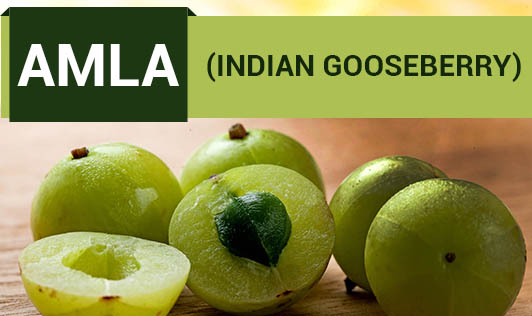Indian Gooseberry (Polyanthus Emblica), commonly known as "Amla'' is a small fruit i.e. grown all over India. This translucent green fruit derives its name from the Sanskrit word 'Amalaki' meaning "nectar of life" which is popular for its ability to restore, rejuvenate and revive the human body.
Amla has got lots of benefits including protection against countless ailments like common cold, sore throat, weak eyesight, and various lifestyle diseases like cancer, diabetes, heart diseases, etc. due to its anti-inflammatory properties. There is no restraint on how Amla should be consumed as it can be used in both fresh or dried forms.
Well, it won’t be wrong to call Amla a "Superfood" because amla has eight times more Vitamin C than an orange, twice the antioxidant power of acai berry, and around 17 times that of a pomegranate.
Let’s find out a few more benefits of this incredible fruit as it has a long list of health benefits to provide us with.
BENEFITS OF AMLA:
- Anti-inflammatory - Amla, being the powerhouse of antioxidants acts as a natural coolant and contains anti-inflammatory properties that help in reducing arthritis.
- Detoxification - Due to the abundance of vitamin C present in amla, this ayurvedic ingredient helps in reduction of free radicals and toxins from our body preventing multiple health issues like aging.
- Boost Immunity - Amla’s antibacterial and astringent properties help to boost immunity, while protecting your body from external pollutants and reducing the risk of diabetes, hypertension and cardiovascular diseases.
- Lowers LDL - Eating amla daily helps in lowering bad cholesterol (LDL) and triglyceride levels that balance the lipids in our body. It also prevents clogs in arteries so if you are suffering from heart ailments, adding amla in your diet can prove to be a wise move.
- Increases Hemoglobin - Due to the presence of vitamin C and iron in amla, it can contribute efficiently in repairing cells and increasing hemoglobin levels by enabling proper circulation of oxygen in the body.
- Control Blood Sugar Levels - Amla has a therapeutic value in diabetics (especially type 2 diabetes) as it improves sugar content in blood by regulating insulin levels that promote healthy pancreas.
- Improves Digestion - Amla is low in calories which makes it an idle food for weight watchers. According to Ayurveda, Amla improves metabolism, helps in preventing indigestion and controls acidity.
AMLA FOR GLOWING SKIN
Amla being rich in antioxidants and collagen is perfect for maintaining skin elasticity. Who doesn’t need younger-looking healthy skin?
- Brightens Skin- Having Amla juice or applying it with honey on your skin will help lighten your skin complexion and lead you to blemish-free skin. Amla is rich in Vitamin C and antioxidants that make your skin healthier and add glow to it.
- Treats acne and scars- As mentioned earlier, it helps in removing toxins thus purifying blood. It helps fight microorganisms that infect the skin with acne and pimples. Try applying the paste of Amla for 10-15 minutes on acne, it will reduce its repeated occurrence.
- Fosters tissue repair- Vitamin C present in Amla has healing properties and antioxidants that speed up the recovery of damaged tissue. Amla juice can be a solution to dry skin problems.
You may also like: Guava leaves benefits for skin hair
AMLA FOR HAIR
- Prevents hair damage- Applying Amla juice prevents multiple hair problems like dandruff, dryness and puts a pause on hair breakage.
- Enhances hair texture- Amla tends to boost hair growth by repairing hair follicles and make them look naturally smooth. Apply Amla paste for 30 minutes, let it dry, and rinse it with lukewarm water.
- Enhances natural color- Amla helps darken the hair and prevent its natural color from degrading. It improves the process of cell pigmentation and it can also be mixed with henna to dye hair.
You may also like: 5 simple hair care tips
HOW TO EAT AMLA?
1. Add grated amla to vegetables, coriander/mint chutneys, salads, cucumber raita, or curd.
2. Drink fresh amla juice with a dash of honey first thing in the morning to give your day an energetic start.
3. Amla can be used as an alternative to tamarind and lemon to add a sour and tangy flavor to food.
4. Use Amla powder (Amla Churna) and amla juice as a salad dressing.
5. Amla candy can be eaten after meals to improve digestion.
6. Amla preserve commonly known as “Amla Murabba” and also Amla pickle should be consumed regularly for more health benefits.
You may also like: Amla honey party shots
MYTH ABOUT AMLA:
Consuming Amla juice or applying Amla on grey hair is a remedy for premature greying of hair.
Fact: Nothing can stop hair from turning grey and it can't be reversed. Amla is a rich source of vitamin C, so it helps maintain healthy hair.
BOTTOM LINE:
Amla is cultivated throughout India, it is easily available and has a long history attached to remedies and treatments from curing indigestion to control diabetes. You can utilize it in multiple forms to keep your skin and hair healthy by either applying it or including it your daily routine.
And, now when you know that Amla has so many benefits, it is time to relish those childhood memories again, sprinkle some chaat masala, and eat it up!
